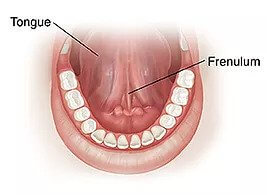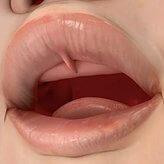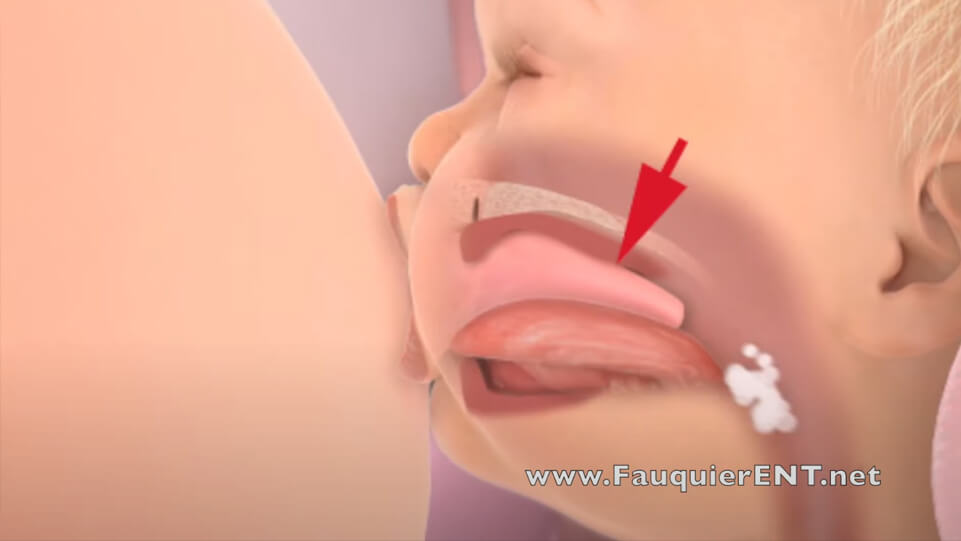INFANT TONGUE TIES “Ankyloglossia”
TONGUE TIE (LINGUAL FRENULUM)
“Ankyloglossia” commonly referred to as a tongue tie is a string of tissue. This tissue is called the frenulum. It connects from the underside of the tongue to the floor of the mouth. You can see it if you look under your tongue in a mirror. This tissue can restrict tongue movements essential for breastfeeding, sucking, swallowing, eating, drinking, chewing, breathing, speech, jaw growth, posture and digestion.

LIP TIE (LABIAL FRENULUM)
Lip tie is a similar band of tissue, called the labial frenulum, that adheres the lip to the gums at a level much higher than normal. This can lead to potential breastfeeding issues, a gap in between upper front teeth, cavities, inability to close the lips without strain and speech difficulties.

CAUSES OF A TONGUE TIE
There have been many such theories and researches behind it, but there is no one concrete reason for it as of today. Some say it’s a defect in cellular apoptosis while some say it’s hereditary. Interestingly, boys have been found to be more susceptible to have a tongue tie.
SYMPTOMS OF A TONGUE TIE
Breastfeeding in infants is considered crucial not just in terms of weight gain for the infant but also developing the right tongue function for a correct jaw development. An unsuccessful breastfeeding journey can make a mother feel like a failure, depressed and stressed. They in turn start supplementing bottles under the notion that they have insufficient milk production. However, at times there may be dysfunctions with the baby’s soft tissues that can be easily resolved. A failure to diagnose tongue and lip ties supplemented along with bottle feeds affects jaw growth, airway development and much more.
For mother’s having trouble breastfeeding, it would be ideal to meet with a pediatric dentist, lactation consultant or a pediatrician who can rule out lactation concerns and then assess if there is any tongue or lip tie that is hindering the process of breastfeeding. comprehensive team based approach is key to treat these patient. At Dentician we also believe in helping a mother through their exhausting breastfeeding journey with emotional and psychological support.
Breast Feeding MOTHER Symptoms
Creased nipples
Blanched nipples
Incomplete breast drainage after feeding
Mastitis / Infected nipples
Nipple Thrush
Reduced milk supply
State of mind: Anxious / Depressed
Breast Feeding INFANT Symptoms
Prolonged latching / long feeding hours
Unsettled after feeding
Poor / shallow latch
Chewing on nipples
Reflux symptoms
Colic symptoms / Gassiness
Falls asleep during feeds
Pulls body away from breast while feeding
Diagnose My Infant’s Tongue Tie
Tongue-tie may be found when looking for causes of a baby’s breastfeeding problems. A tongue tie cannot be diagnosed by seeing if the child can stick out the tongue outside the mouth. Evidence based current approach shows that a comprehensive functional assessment of the tongue is essential. There are other signs beyond just the appearance of the tongue, on the face and body, that only a well trained tongue tie professional can assess.
TREATING A TONGUE TIE
After a thorough history taking and clinical examination, depending on the severity of the condition the treatment is advised. In severe cases, a frenotomy is advised. It can be performed using scissor or laser technique. The Laser Procedure is a safe, quick, simple and painless procedure which generally requires no anesthesia. Oral Myofunctional Therapy is given as an adjunct to rehabilitate the tongue function and avoid any relapses. In some infants, Craniosacral Therapy may be used as an adjunct when some asymmetry in the head shape or problems with neck stabilisation have been observed. Postoperative stretches, a functional release and a team approach is the key to a successful frenotomy. This is what sets us apart. Please go through these resources for additional understanding.

RISKS OF AN UNTREATED TIE
Selective in chewing solid foods
Speech defects
Improper jaw growth
Crooked teeth
Forward neck and shoulder posture
Long term bed wetting
Hyperactivity / Lack of attention (ADD, ADHD)
Snoring / Noisy breathing
The above mentioned risks are examples of observed changes in children. NOT ALL TIES SHOW all the above mentioned risks. It takes an experienced provider to thoroughly investigate the tongue function and symptoms associated with each tie.
TONGUE TIE RELEASE: AN AGE OLD TREATMENT
Until this 19th century Midwives were known to clip a newborn’s tongue-tie at birth with a sharp fingernail if spotted with breastfeeding issues. The second half of the 20th century saw a movement away from the practice of breastfeeding. It may have been caused by the rise of formula and bottle feeding, which together, made diagnosing a tongue tie as a long-lost art.
That means there are two to three generations that grew up with tongue-ties. It’s a large group of adults who are living in the dark and are experiencing its signs and symptoms that could unknowingly have a tongue-tie and its compensations.
Our Advanced & Globally Renowned Tongue Tie Procedures:
Blogs


























